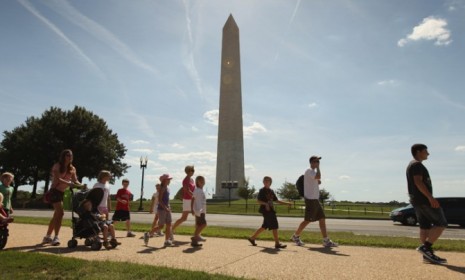The East Coast's 'historic' earthquake: 6 interesting facts
The rare temblor that rattled Virginia on Tuesday had geologists dusting off their history books — while Californians snickered

On Tuesday, a rare 5.8-magnitude earthquake spooked the East Coast; while its epicenter was in rural Virginia, it was felt as widely as Georgia, New York, Ohio, and even Canada. (Earlier in the day, Colorado also experienced its biggest temblor in more than 40 years, a smaller 5.3-magnitude quake near the New Mexico border.) Although much less powerful than the temblors that frequently shake the West Coast, the Virginia quake "was an historic earthquake for the East Coast," says Columbia University seismologist Lynn Sykes. Here, six compelling facts about the East Coast's biggest earthquake in 67 years:
1. Temblors shook George Washington's Virginia, too
An earthquake in Virginia isn't unprecedented. According to the U.S. Geological Survey, a February 1774 quake shook the Richmond area so heavily that houses were knocked off their foundations. Another rumble in 1828, centered in southwestern Virginia, was felt in Washington; President John Quincy Adams compared it to being on a rolling ship at sea. But "the Mother of All American Earthquakes," says Landon Jones at The Huffington Post, was in December 1911, a roughly 7.7-magnitude stunner centered near New Madrid, Mo., but felt as far away as New York, Washington, and Charleston, S.C. The last East Coast quake as big as Tuesday's was in 1944, in New York.
The Week
Escape your echo chamber. Get the facts behind the news, plus analysis from multiple perspectives.

Sign up for The Week's Free Newsletters
From our morning news briefing to a weekly Good News Newsletter, get the best of The Week delivered directly to your inbox.
From our morning news briefing to a weekly Good News Newsletter, get the best of The Week delivered directly to your inbox.
2. The East Coast is tectonically landlocked — which makes quakes rare
Roughly 99 percent of earthquakes occur when one of the Earth's dozen or so tectonic plates rubs up against another, but the other 1 percent happen in the middle of plates, along smaller fault lines. California is 100 times more seismically active than the East Coast because it sits at the edge of a giant plate that stretches all the way to the center of the Atlantic Ocean; Virginia sits in the middle of the plate. The fault line through central Virginia is no more than a few miles long, says seismologist Kate Hutton.
3. But East Coast quakes are felt over a wider area
Large California quakes are rarely felt more than a few hundred miles from the epicenter, but the Virginia temblor shook buildings in Maine, more than 900 miles away. That's no surprise, says USGS earthquake geologist David Schwartz. "The [Earth's] crust in the East is different than in the West. It's older and colder and denser, and as a result, seismic waves travel much further." The Virginia quake was also unusually shallow, which means it was felt more strongly on the surface, says Alex Madrigal at The Atlantic.
A free daily email with the biggest news stories of the day – and the best features from TheWeek.com
4. East Coast quakes can still be dangerous
The good news about dense rock is that in an earthquake, "the shaking is less intense, making damage less likely," says Tamara Audi in The Wall Street Journal. The bad news: Earthquakes hit a wider area, and "many East Coast buildings are old and not retrofitted to withstand quakes like buildings on the West Coast." The building codes out East are much more lax when it comes to seismic safety, says Brian Palmer at Slate. But "if you work in the Empire State Building or the Chrysler building and [Tuesday's] earthquake has you worried, breathe easy": Skyscrapers are built to withstand strong winds, which sway tall buildings as much as a big earthquake would.
5. Tuesday's quake caused relatively little damage
The Virginia temblor rattled nerves and disrupted workdays and commutes, but it apparently caused no truly major damage, deaths, or even major injuries. The 5.8 quake did temporarily close airports across the region, along with 10 nuclear power plants, most notably Virginia's North Anna plant. It also caused "significant" damage to Washington's National Cathedral and, reportedly, opened a few cracks near the top of the Washington Monument — though it didn't knock the world's tallest obelisk off-kilter, despite reports on Fox News and Twitter that the monument was leaning.
6. And Californians loved mocking panicked East Coasters
After their plates stopped rattling and books stopped dropping, "shaken Easterners could hear another sound from Tuesday's magnitude-5.8 quake," says the AP's Jacob Adelman: "Snickering emanating from opposite side of the continent." On TV, Twitter, and Facebook, earthquake-hardened West Coasters mocked East Coasters and the East Coast media for panicking over a mere 5.8 quake, and for running outside of their buildings — the exact opposite of what you're supposed to do. OK, Californians, we get that you're earthquake pros, says Adrian Chen at Gawker. Now "shut up and let us wallow in our abject terror."


